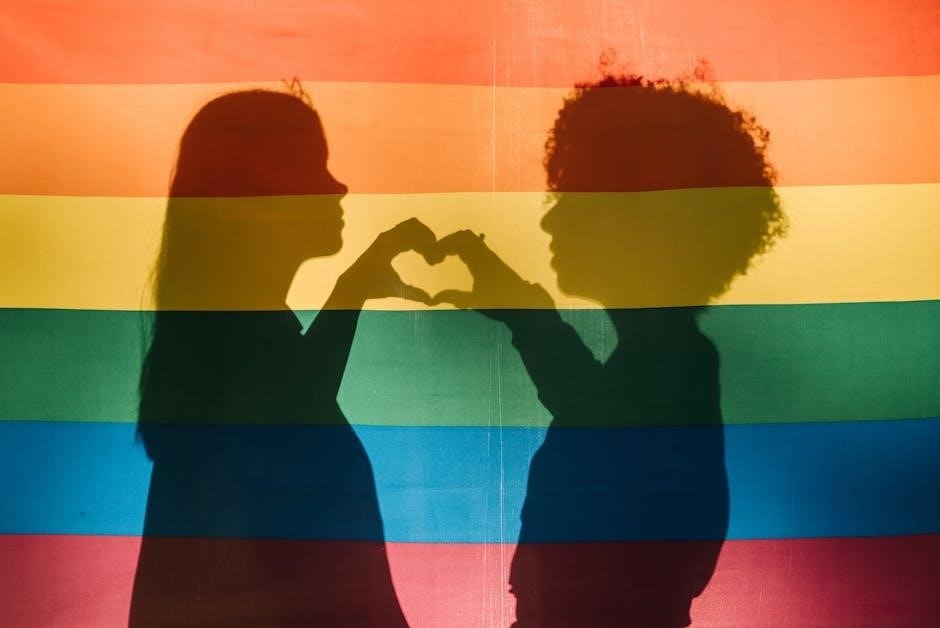Sexuality is a complex and multifaceted aspect of human life, encompassing biological, psychological, and social dimensions. It includes sexual behavior, identity, and attraction, shaped by cultural and personal experiences.
Understanding sexuality involves exploring its role in intimacy, reproduction, and personal identity. It evolves across the lifespan and is influenced by factors like gender, orientation, and societal norms.
Definition and Scope of Sexuality
Sexuality refers to the complex interplay of biological, psychological, and social factors that shape an individual’s sexual identity, behavior, and experiences. It encompasses sexual orientation, gender roles, intimacy, and reproduction, while also influencing personal and relational dynamics. Sexuality is a central aspect of being human, reflecting how individuals express and experience attraction, pleasure, and connection.
The scope of sexuality extends beyond physical acts, incorporating emotional, cultural, and societal dimensions. It is shaped by diverse factors, including culture, religion, personal values, and biological drives. Understanding sexuality requires examining its multifaceted nature, as it plays a pivotal role in defining identity and shaping human interactions across the lifespan.
The Multidimensional Nature of Sexuality
Sexuality is a deeply multidimensional concept, extending beyond physical acts to encompass emotional, psychological, and social dimensions. It involves biological drives, personal identity, and cultural influences, shaping how individuals experience attraction, intimacy, and pleasure. This complexity highlights the interplay between innate factors, such as sexual orientation, and external forces, like societal norms and personal values.
The multidimensional nature of sexuality also reflects its dynamic and evolving character. It incorporates elements of gender identity, eroticism, and relational dynamics, while being influenced by life experiences and cultural contexts. Understanding this multifaceted nature requires exploring how biological, psychological, and social factors intersect to define individual and collective expressions of sexuality.
Importance of Understanding Sexuality
Understanding sexuality is crucial for fostering personal well-being and healthy relationships. It empowers individuals to navigate their desires, identities, and behaviors with confidence and awareness. By exploring the complexities of sexuality, people can address misconceptions and reduce stigma surrounding sexual diversity.
Comprehensive knowledge of sexuality also promotes sexual health and safety. It enables individuals to make informed decisions about consent, protection, and intimacy. Moreover, understanding sexuality supports the development of inclusive societies that respect diverse sexual orientations and gender identities, contributing to overall social harmony and equality.

Cultural and Social Perspectives on Sexuality
Cultural and social perspectives on sexuality vary widely, shaped by norms, beliefs, and values that influence sexual behaviors and identities across different societies and historical periods.
Cultural Differences in Sexual Behavior
Cultural differences in sexual behavior are profound, reflecting varying norms, values, and taboos across societies. Some cultures emphasize modesty and restrict sexual expression, while others embrace openness and diversity. These differences influence attitudes toward premarital sex, same-sex relationships, and sexual practices. For instance, certain societies prioritize virginity before marriage, while others view sexual exploration as a natural part of life. Additionally, religious and traditional beliefs often shape sexual behaviors, dictating acceptable practices and moral standards. Understanding these cultural variations is crucial for fostering respect and addressing sexual health disparities. Such differences highlight the complex interplay between culture and sexuality, emphasizing the need for culturally sensitive approaches in education and healthcare.
The Role of Society in Shaping Sexual Norms
Society plays a pivotal role in shaping sexual norms by establishing expectations, values, and regulations that govern sexual behavior. Cultural, religious, and legal frameworks often dictate what is deemed acceptable or unacceptable, influencing individuals’ attitudes and practices. For example, some societies promote conservative norms, restricting sexual expression to marital relationships, while others embrace liberal attitudes, encouraging sexual diversity and autonomy. Media, education, and social institutions further reinforce these norms, shaping perceptions of gender roles, sexual orientation, and appropriate behavior. These societal influences can either foster healthy sexual expression or perpetuate stigma and inequality. Understanding how society shapes sexual norms is essential for addressing disparities and promoting inclusive, equitable sexual health outcomes.
Cross-Cultural Variations in Sexual Practices
Sexual practices vary significantly across cultures, reflecting diverse values, beliefs, and traditions. Some societies emphasize monogamy and marital fidelity, while others accept polygamy or non-monogamous relationships; In certain cultures, sexual practices are tightly regulated by religious or moral codes, while others embrace sexual liberation and diversity. For instance, some Indigenous cultures have historically recognized non-heterosexual identities and practices, whereas others have strict gender norms. Regional differences also exist in attitudes toward premarital sex, contraception, and same-sex relationships. These variations highlight the complex interplay between cultural, historical, and social factors in shaping sexual behaviors. Understanding these differences is crucial for fostering cross-cultural empathy and addressing sexual health disparities worldwide. Additionally, globalization and migration have led to the blending of sexual practices, creating new dynamics in sexual expression and identity.

Biological and Psychological Aspects of Sexuality
Sexuality is influenced by biological factors like genetics, hormones, and neural activity, as well as psychological elements such as emotions, cognition, and past experiences, shaping sexual behavior and identity.
Biological Foundations of Sexuality
The biological foundations of sexuality are rooted in genetics, hormones, and neurophysiology. Sex determination begins at conception, with chromosomes like XX or XY influencing development. Hormones such as testosterone and estrogen regulate sexual differentiation and desire. Brain structures, including the hypothalamus and limbic system, play crucial roles in sexual arousal and behavior. These biological components interact to shape sexual functions, from reproduction to pleasure, forming the basis of human sexuality. Understanding these mechanisms provides insight into the universal aspects of sexual health and behavior across diverse populations and cultures.
Psychological Factors Influencing Sexual Behavior
Psychological factors significantly influence sexual behavior, shaping desires, preferences, and interactions. Personal beliefs, emotional states, and past experiences contribute to an individual’s sexual identity and practices. Shame and guilt, often rooted in cultural or religious norms, can suppress or alter sexual expression. Emotional intimacy and attachment styles also play a role, as they influence how individuals connect sexually. Additionally, psychological traits like self-esteem and confidence impact sexual confidence and satisfaction. Societal expectations and gender roles further mold sexual behavior, creating norms that individuals may conform to or resist. Understanding these psychological dimensions is essential for addressing sexual health and promoting positive sexual well-being across diverse populations and contexts.
The Interplay Between Biology and Psychology
The interplay between biology and psychology is central to understanding human sexuality. Biological factors, such as hormones and genetics, shape sexual desire and response, while psychological elements, including emotions, thoughts, and societal influences, further mold sexual behavior. Hormones like testosterone and estrogen regulate libido and arousal, demonstrating biology’s role. Simultaneously, psychological factors like emotional intimacy, self-esteem, and cultural norms influence how individuals express their sexuality. The interaction between these domains highlights the complexity of sexual experiences, as biological drives are filtered through psychological and social lenses. This dynamic interplay underscores the importance of considering both biological and psychological perspectives to fully comprehend human sexuality and its diverse expressions across individuals and cultures.

Sexual Orientation and Gender Identity
Sexual orientation and gender identity are deeply interrelated, shaping how individuals experience attraction and self-identify. They form a spectrum of human diversity, influencing personal and societal expressions.
Understanding Sexual Orientation
Sexual orientation is a complex and deeply personal aspect of human sexuality, referring to an individual’s pattern of emotional, romantic, or sexual attraction to others. It is shaped by a combination of biological, psychological, and cultural factors. Sexual orientation exists on a spectrum, ranging from exclusive attraction to the opposite gender (heterosexuality) to attraction to the same gender (homosexuality) or both (bisexuality). It can also vary in intensity and expression over time. Understanding sexual orientation is crucial for promoting mental health, self-acceptance, and inclusive societies. Societal norms and attitudes significantly influence how individuals experience and express their sexual orientation, emphasizing the need for respect and acceptance of diverse identities.
Gender Identity and Its Relation to Sexuality
Gender identity refers to an individual’s internal sense of their own gender, which may or may not align with the sex assigned at birth. It is a key component of human sexuality, influencing how individuals express themselves and experience attraction. Gender identity and sexual orientation are distinct but interconnected concepts, as both shape personal identity and sexual expression. Societal norms and cultural expectations often influence how gender identity is perceived and expressed, impacting an individual’s sexual experiences and relationships. Understanding the relationship between gender identity and sexuality is essential for fostering inclusivity and respecting diverse expressions of human sexuality. It highlights the importance of recognizing and validating individuals’ experiences beyond binary frameworks, promoting a more nuanced understanding of human diversity.
The Spectrum of Sexual Orientations
Sexual orientation exists on a spectrum, encompassing a range of attractions beyond heterosexuality and homosexuality. This includes bisexuality, pansexuality, asexuality, and demisexuality, among others. Each orientation reflects different patterns of emotional, romantic, or sexual attraction to others. The spectrum acknowledges that individuals may experience fluidity in their attractions over time, challenging traditional binary views of sexuality. Recognition of this diversity is crucial for promoting inclusivity and understanding. Societal acceptance of the sexual orientation spectrum has grown, though challenges remain in ensuring equal rights and respect for all individuals, regardless of their orientation. Education and dialogue play vital roles in fostering a more accepting and informed society. By embracing this spectrum, we affirm the complexity and richness of human sexual experiences, contributing to a more inclusive and compassionate world.

Sexuality Education and Health
Sexuality education is crucial for promoting sexual health and well-being. It equips individuals with knowledge to make informed decisions, fostering responsibility, safety, and overall health in sexual experiences.
The Role of Sexuality Education
Sexuality education plays a vital role in promoting sexual health and well-being. It equips individuals with accurate knowledge and skills to make informed decisions about their sexual lives.
Effective programs address biological, emotional, and social aspects of sexuality, emphasizing consent, gender identity, and healthy relationships. They also aim to prevent unhealthy behaviors, such as unsafe sex, by fostering responsibility and awareness.
Current materials often lack inclusivity, failing to meet the needs of diverse groups, including non-heterosexual individuals. Tailored education can ensure all individuals have the tools to navigate their sexuality safely and responsibly.
Sexual and Reproductive Health

Sexual and reproductive health is a fundamental aspect of overall well-being, encompassing physical, emotional, and mental health. It involves ensuring access to safe and effective sexual health services, including contraception and STI prevention.
A positive and respectful approach to sexuality is crucial for promoting sexual health. This includes addressing sexual dysfunction, ensuring sexual satisfaction, and fostering healthy relationships.
Education and awareness are key to preventing unintended pregnancies and sexually transmitted infections. Access to comprehensive sexual health services empowers individuals to make informed decisions about their reproductive and sexual lives.
Addressing sexual health concerns requires a holistic approach, considering cultural, social, and psychological factors. This ensures that individuals can lead sexually healthy and fulfilling lives.
Addressing Sexual Health Concerns
Addressing sexual health concerns requires a comprehensive and inclusive approach. This involves early detection and treatment of sexually transmitted infections (STIs), providing access to contraceptives, and promoting sexual health education.
Stigma and cultural barriers often hinder individuals from seeking help, emphasizing the need for non-judgmental and confidential services. Public health campaigns can raise awareness and encourage regular screenings.
Mental health is intricately linked to sexual well-being. Psychological support for issues like sexual dysfunction or trauma is essential for overall health.
Collaboration between healthcare providers, educators, and policymakers is vital to create supportive environments for sexual health. This collective effort ensures equitable access to resources and care.
By prioritizing sexual health, societies can reduce disparities and foster healthier communities.

Sexuality Across the Lifespan
Sexuality evolves throughout life, influenced by age, experience, and societal norms. It encompasses intimacy, pleasure, and identity, remaining a vital aspect of human experience from youth to old age.
Sexuality in Older Adults

Sexuality in older adults remains a vital aspect of life, often shaped by physical changes, societal perceptions, and emotional experiences. As people age, sexual behavior may evolve, but intimacy and pleasure continue to play significant roles in well-being. Research highlights that older adults maintain sexual desires and engage in sexual activities, though frequencies and preferences may shift. Emotional connection and companionship often become more pronounced, reflecting a deeper need for intimacy. Cultural attitudes toward aging and sexuality can influence how older adults express their sexuality. Healthcare providers increasingly recognize the importance of addressing sexual health concerns in older populations, ensuring they have access to resources and support. Understanding and respecting the sexual experiences of older adults is crucial for promoting holistic health and dignity in later life.
This perspective underscores the continuity of sexuality across the lifespan, emphasizing its enduring relevance beyond reproductive years.
The Evolution of Sexual Behavior with Age
The evolution of sexual behavior with age reflects a dynamic interplay of biological, psychological, and social factors. As individuals transition through life stages, their sexual practices and priorities often shift. Younger adults may focus on exploration and intimacy, while older adults may emphasize emotional connection and companionship. Physical changes, such as hormonal fluctuations and health conditions, can influence sexual frequency and preferences. Societal attitudes toward aging and sexuality also play a role, sometimes perpetuating stereotypes that diminish the sexual agency of older adults. Despite these challenges, many people maintain active and fulfilling sexual lives well into older age, adapting their behaviors to align with changing needs and desires. This evolution highlights the resilience and adaptability of human sexuality across the lifespan.
Understanding these changes is essential for promoting sexual health and well-being at every life stage.
Maintaining Sexual Health in Later Life
Maintaining sexual health in later life involves addressing physical, emotional, and relational factors. As individuals age, physiological changes such as hormonal shifts or chronic health conditions can impact sexual function. Open communication with partners and healthcare providers is crucial for adapting to these changes. Regular check-ups and discussions about sexual health can help identify and manage issues early. Emotional intimacy and affectionate connections remain vital, even as sexual activity may evolve. Older adults can benefit from exploring non-sexual forms of intimacy, such as cuddling or shared activities, to maintain connection. Societal perceptions often overlook the sexual lives of older adults, but with awareness and support, they can continue to experience fulfilling relationships and sexual well-being.
Education and resources tailored to aging populations can empower individuals to prioritize their sexual health and emotional satisfaction in later life.

Sexuality in Specific Populations
Sexuality varies among specific populations, including non-heterosexual individuals and prison communities. Factors like societal norms, identity, and environmental constraints shape their sexual behaviors and experiences distinctly.

Sexuality Among Non-Heterosexual Individuals
Sexuality among non-heterosexual individuals encompasses a diverse range of experiences, including lesbian, gay, bisexual, and other queer identities. These individuals often face unique challenges in expressing their sexuality due to societal norms and stigma. Research indicates that non-heterosexual individuals may experience sexual orientation as a core aspect of their identity, influencing their relationships and behaviors. The exploration of sexual orientation can be a significant part of their personal journey, often involving self-discovery and navigation of societal expectations. Additionally, studies highlight the importance of supportive environments in fostering healthy sexual development and expression among non-heterosexual individuals. Despite progress, many still encounter discrimination, which can impact their mental health and sexual well-being. Understanding and addressing these challenges is crucial for promoting inclusivity and equality.
Sexuality in Prison Populations
Sexuality in prison populations is a complex and often underexplored topic, shaped by the unique environment of confinement. Research indicates that sexual behavior in prisons is influenced by factors such as the absence of the opposite sex, power dynamics, and the formation of alternative social hierarchies. Sociologists, psychologists, and penologists have studied inmate-to-inmate sexuality for over 90 years, highlighting its multifaceted nature. Sexual identities and behaviors in prisons can vary widely, with some individuals engaging in same-sex interactions despite identifying as heterosexual outside of the prison context. The lack of privacy and the prevalence of coercion further complicate the expression of sexuality in these settings. Additionally, the challenges of addressing sexual health and consent within prisons pose significant concerns for the well-being of inmates. Understanding sexuality in prison populations requires a nuanced approach that considers both individual experiences and systemic influences.
Sexuality is a central aspect of human life, encompassing identity, behavior, and intimacy, shaped by biological, psychological, and cultural influences across the lifespan.
Summarizing the Complexity of Sexuality
Sexuality is a deeply intricate and multifaceted aspect of human life, shaped by biological, psychological, and sociocultural factors. It encompasses sexual orientation, gender identity, intimacy, and sexual behavior, all of which vary widely across individuals and cultures. The interplay between biology and psychology influences desires, behaviors, and identities, while societal norms and personal experiences further complicate its expression. Sexuality evolves throughout the lifespan, with factors like age, health, and relationships playing significant roles. Understanding sexuality requires a holistic approach, recognizing its connection to emotional, physical, and mental well-being. Education and open dialogue are essential for fostering healthy attitudes toward sexuality, addressing misconceptions, and promoting inclusivity for all individuals, regardless of their orientation or identity.
